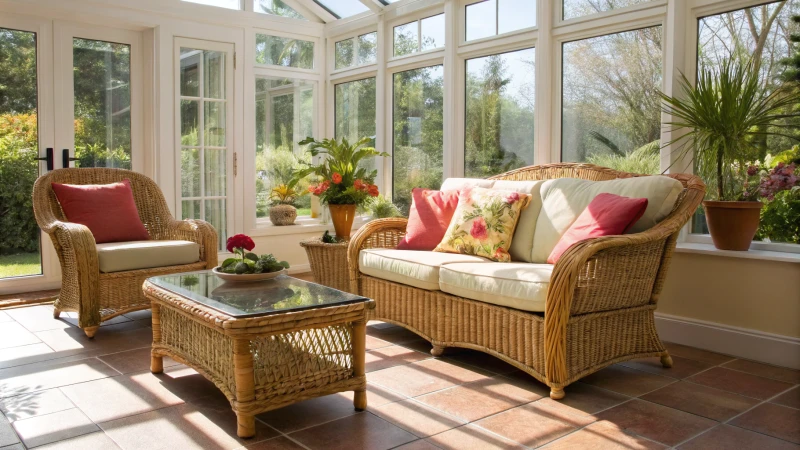
Have you ever admired the beauty of rattan furniture? Let’s explore its world even more!
Rattan is a flexible material often used in furniture. It has many uses beyond furniture. Rattan appears in home decor. Traditional crafts also use rattan. Some people use it for medicine. Rattan is very important in sustainable design. It is really valuable.
Rattan is much more than just beautiful furniture. My first experience with a rattan chair happened in a cozy café. It felt like a warm embrace. Since that day, I discovered rattan’s origins in many cultures. People use it for home decoration, traditional crafts and even medicine. This variety makes rattan very exciting to learn about.
In this blog post, we will explore the many uses of rattan together. Emily, an experienced buyer for an eco-friendly brand, knows a lot about it. You may be like her or just interested in this amazing material. You will probably find insights that connect with your experiences and goals.
Rattan is only used for making furniture.False
This claim is false as rattan has diverse applications beyond furniture, including decor and crafts.
Rattan has medicinal uses in traditional practices.True
This claim is true; rattan is known for its medicinal properties in various cultures.
What are the Traditional Uses of Rattan?
Rattan is a climbing palm with a rich history. It weaves through cultures and communities. People use rattan in many traditional ways. Join me as I explore the fascinating ways rattan has shaped lives around the globe. Rattan really influences livelihoods worldwide.
Rattan has traditionally been used for crafting furniture, tools and household items in Southeast Asia. People find it very useful for many purposes. Communities rely on rattan for both economic livelihoods and preserving cultural heritage. Many villagers value its versatility.
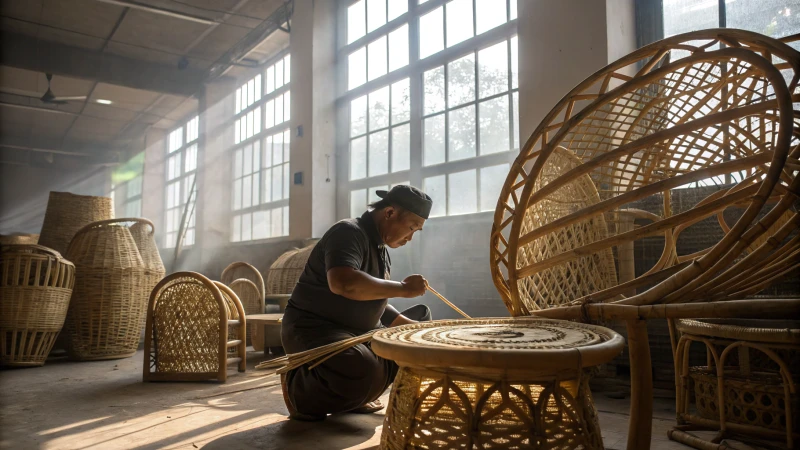
Traditional Rattan Craftsmanship
Rattan is more than a plant. It is vital for many Southeast Asian communities. I remember my first visit to a market in Indonesia. I was amazed by the bright colors and detailed designs of rattan goods. Walking through felt like entering a world where each item told a story. These stories came from the skill and heritage of the artisans who made them.
Rattan is central to traditional craftsmanship in Southeast Asia. Many artisans shared stories with me. Their families have passed weaving skills across generations. They create not just furniture but also art that reflects local traditions. I found the rattan chairs in a small café especially interesting. Each one seemed to invite me to sit down and enjoy coffee.
In Indonesia and Malaysia, rattan weaving is a cultural treasure. Artisans combine creativity with usefulness. They produce stylish baskets and strong furniture. Each piece shows a part of their identity and community spirit. I always admire the timeless beauty of rattan furniture in modern places.
To discover more about these techniques, visit our article on rattan weaving techniques1.
Economic Importance of Rattan
Rattan is not only beautiful but also very important for the economy. During my travels, I learned how sustainable harvesting provides jobs for many in rural areas. It changes lives and respects nature. I spoke with farmers who grow rattan. Their pride in helping their local economy was clear.
The rattan industry helps the GDP of countries like the Philippines and Thailand. Farmers cultivate rattan as a sustainable income source while supporting biodiversity. The balance between harvesting and conservation is inspiring, ensuring long-term viability for this resource.
For more insights on the economic impact, check our guide on sustainable rattan sourcing2.
Daily Life Uses of Rattan
Rattan is very versatile. People have used it in daily life for many years. In a rural village, I saw families use rattan for baskets and sleeping mats, showcasing their resourcefulness as they turn what some see as just a plant into essential tools.
These uses show the creativity of communities that depend on rattan for their everyday needs:
| Item | Traditional Use | Region |
|---|---|---|
| Baskets | Carrying goods | Indonesia |
| Mats | Sleeping surfaces | Malaysia |
| Furniture | Seating and tables | Thailand |
| Decorative | Cultural ornaments | Philippines |
I appreciate each product more when I understand its practical use. Emily, who loves design like I do, also sources these lovely pieces; she values the craftsmanship behind them just as much.
To learn more about rattan’s many uses, check our piece on rattan in everyday life3.
Rattan weaving is a cultural heritage in Southeast Asia.True
Rattan weaving is deeply rooted in the traditions of Southeast Asian cultures, showcasing their craftsmanship and cultural identity.
Rattan contributes significantly to the GDP of Southeast Asian countries.True
The rattan industry plays a crucial role in the economies of countries like Thailand and the Philippines, boosting local GDPs through sustainable practices.
How Can Rattan Transform Sustainable Design?
Have you ever wondered how the materials we pick affect the Earth? Rattan offers more than just beauty for home decoration. It changes the game in eco-friendly design. This amazing material really creates a positive impact.
Rattan adds to sustainable design because it is renewable. It has a low carbon footprint. Additionally, rattan biodegrades easily. Skilled artisans craft rattan into various designs. The material offers great versatility. Rattan provides many options. Choosing rattan means not only selecting a beautiful piece. You also pick an eco-friendly choice.
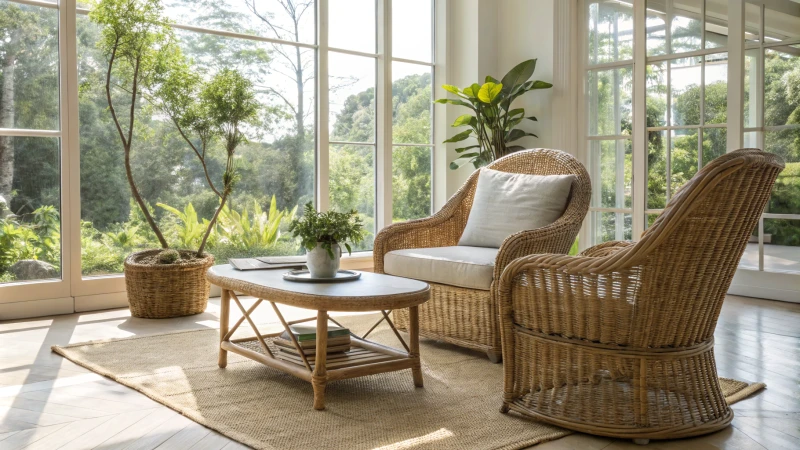
Rattan as a Renewable Resource
When I first discovered rattan in my home décor journey, its beauty and flexibility amazed me. What truly struck me was its ability to help create a more sustainable world. Rattan is popular with green-minded people and designers. It deserves a place in your heart and home.
Imagine a lush tropical forest where rattan vines twist and grow peacefully with nature. This is where rattan lives – a climbing palm that grows quickly in mixed forests. Unlike hardwood trees that need decades to mature, rattan is ready to use in just a few years. We enjoy its beauty without damaging our forests.
Rattan harvesting supports biodiversity and that fact surprised me. Local people rely on it for their livelihoods. It allows them to protect their natural surroundings and support their families. It’s truly amazing. By choosing rattan, I don’t just select a product; I protect an entire ecosystem.
Low Carbon Footprint
I often worry about how materials affect the planet. Rattan eases my mind because it has a very low carbon footprint. As it grows, it traps carbon, which helps reduce emissions. Producing rattan requires much less energy compared to plastic or metal, which I try to avoid.
When I pick rattan over other materials, I feel like I’m taking a small, meaningful step against climate change. This choice matches my values. I feel proud to help find a solution.
Biodegradability and End-of-Life Considerations
Let’s think about what happens when we finish using products. Rattan’s biodegradability is one of its best features. Unlike synthetic materials that stay in landfills for ages, rattan breaks down naturally and enriches the soil. This deeply resonates with me because it aligns with my commitment to sustainability.
In my designs, I consider their impact long after they’re used. Rattan allows me to make beautiful, functional spaces without harming our planet. If you’re curious about other sustainable materials, see our guide on sustainable design materials4.
Craftsmanship and Ethical Production
I love that artisans often handcraft rattan. Every piece tells a skillful and dedicated story, bringing character to any space. Supporting these artisans means supporting fair wages and better working conditions. I look for these values when I choose products.
By choosing rattan, I know I’m backing quality craftsmanship and uplifting communities. I seek brands prioritizing ethical practices. Look for certifications that guarantee your purchases’ integrity. Explore ethical sourcing with our resources on ethical sourcing practices5.
Versatility in Design
Rattan’s versatility truly amazes me. From beautiful furniture to charming decorative items, it fits into various styles easily. I love how lightweight it is; transporting rattan saves energy during shipping.
As a designer, I enjoy rattan’s flexibility; it can form intricate patterns or stay natural, offering endless creative possibilities fitting today’s aesthetics. To see modern rattan uses, check out our article on modern rattan applications6.
Rattan isn’t just a trend; it’s a step toward a more sustainable future! Choosing this special material helps protect our planet while beautifying our homes.
| Aspect | Rattan | Other Materials |
|---|---|---|
| Growth Rate | Fast (3-7 years) | Slow (decades for hardwood) |
| Carbon Footprint | Low | High |
| Biodegradability | Yes | No (most synthetic options) |
| Craftsmanship | Handcrafted | Mass-produced |
| Versatility | High | Varies (depends on material) |
Rattan can be harvested in just a few years.True
Rattan's rapid growth allows for sustainable harvesting, unlike hardwood trees that take decades to mature.
Rattan is not biodegradable and harms the environment.False
Contrary to this claim, rattan is biodegradable and decomposes naturally, benefiting the ecosystem.
What Types of Products Can be Made from Rattan?
Ever wondered about the amazing possibilities of rattan? I’m always fascinated by this flexible material. Rattan transforms into many beautiful items. Really, let’s explore the world of rattan and find the treasures it creates!
Rattan changes into many products like furniture. People create chairs, tables and sofas with it. Rattan also turns into lighting items like pendant lights and lamps. It also becomes beautiful decorative items like baskets and wall art. DIY crafts often use this material. Its versatility really suits eco-friendly home decor.
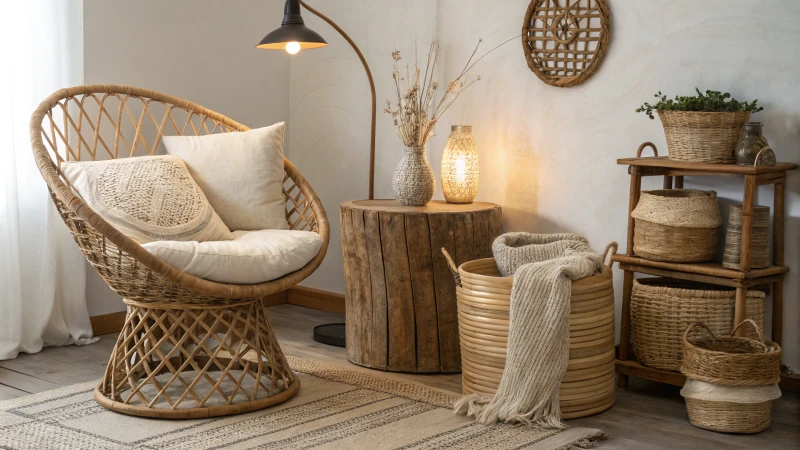
Rattan Furniture
Rattan often reminds me of furniture first. My first experience sitting on a rattan chair was memorable. It felt light as a feather but was strong enough to hold me comfortably. That wonderful mix of strength and style really makes people love rattan furniture.
Here I share a few classic pieces that I adore:
| Product Type | Description | Use Case |
|---|---|---|
| Chairs | Lightweight, comfortable seating | Living rooms, patios |
| Tables | Stylish and functional surfaces | Dining areas, outdoor spaces |
| Sofas | Cozy seating arrangements | Living rooms, lounges |
| Beds | Elegant and sturdy frames | Bedrooms, guest rooms |
Rattan furniture usually has a natural finish that complements various interior styles, making it an excellent choice for eco-conscious decorators. If you’re interested in eco-friendly furniture styles, explore sustainable furniture trends7.
Rattan Lighting
Rattan isn’t limited to just furniture. It also forms very beautiful lighting designs. I always notice how a well-placed rattan pendant light changes a room’s atmosphere. The warm light streaming through the weave creates a cozy feel in every space.
Here are a few examples:
- Pendant Lights: Ideal for dining rooms or kitchen islands.
- Table Lamps: Perfectly cozy for living rooms or bedrooms.
- Wall Sconces: Beautifully brighten hallways or entrances.
The dance of light and shadow from rattan weaving is pure art. For talented lighting ideas, discover creative lighting solutions8.
Rattan Home Decor
Rattan goes beyond furniture and lighting to offer decorative items that add charm to your home. I always think small details really alter home decor.
Here are some delightful rattan decor items:
| Decor Item | Description | Purpose |
|---|---|---|
| Baskets | Storage solutions that are stylish | Organizing spaces, decoration |
| Wall Art | Handcrafted pieces for decoration | Home styling, accent walls |
| Mirrors | Frames made from rattan | Adding dimension to rooms |
These handmade pieces display remarkable artistry and sustainability. They really attract those who care for our planet. For more planet-friendly decor ideas, visit eco-friendly decor ideas9.
Rattan Crafts and DIY Projects
Rattan encourages hands-on creativity. Crafting with rattan is simply joyful! I take pleasure in creating things that are useful and add personal character to my home.
Consider trying these fun DIY projects:
- Rattan Wall Hangings: Stunning wall art with simple weaving techniques.
- Rattan Plant Hangers: Show off plants stylishly with a bohemian flair.
- Rattan Storage Solutions: Make custom baskets or organizers for every space.
These projects allow creativity to flow while supporting sustainable actions. If crafting with natural materials intrigues you, explore DIY natural crafts10.
Rattan is used primarily for furniture making.True
Rattan's lightweight and durable nature makes it a popular choice for crafting various types of furniture, including chairs, tables, and sofas.
Rattan cannot be used in lighting fixtures.False
Contrary to this claim, rattan is effectively transformed into stylish lighting fixtures like pendant lights and table lamps, enhancing home decor.
What Makes Rattan So Irresistibly Popular in Home Decor?
Rattan is loved by me and many others who decorate homes. It is easy to understand why this is the case! The material looks charming and is kind to the environment. Rattan is also very versatile. This makes it perfect for creating cozy and inviting places. Let us explore this interesting trend!
Rattan is popular in home decor due to its natural beauty, sustainability and versatility. This strong material fits well with different interior styles. Homeowners like it for its look and practicality. Rattan stays a favorite for many.
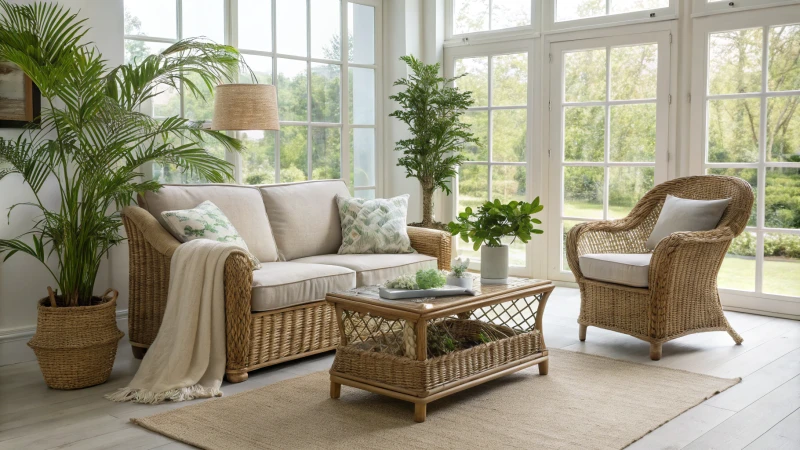
Aesthetic Appeal of Rattan
Rattan’s rise in popularity is not just a passing trend. Many choose it for its comforting appeal. I recall visiting a friend’s house filled with rattan furniture. The natural warmth and inviting textures immediately relaxed me. It felt like a cozy embrace! Rattan is not just about appearance; it creates a pleasant atmosphere.
Rattan brings natural textures and warm hues to mind, adding life to any room easily. The look feels like bringing nature indoors, creating a calm setting. A chic rattan chair in my living room or a lovely pendant light in the dining space adds charm. Rattan gives depth and character.
Rattan suits different design styles well. Bohemian designs use rattan to create cozy corners filled with plants and vibrant textiles, making spaces inviting and telling a story.
Sustainability Factor
As environmental awareness grew, rattan became a favorite for its sustainability. This renewable resource grows fast and can be harvested without causing harm to its surroundings. Choosing rattan supports eco-friendly practices, which makes me feel good about this choice.
Friends like Emily also love sustainable products. Rattan speaks to our wish for a greener planet while being stylish too—it’s truly a win-win situation!
Durability and Functionality
Rattan draws me in with its durability; some materials fade over time, but rattan stays strong through daily use. My sturdy rattan chair remains beautiful, just like the day I bought it.
Moreover, rattan’s lightweight nature makes moving furniture easy. Whether hosting a casual gathering or rearranging for a fresh look, it’s simple to shift things without losing style.
| Feature | Rattan | Other Materials |
|---|---|---|
| Sustainability | Highly sustainable | Varies |
| Durability | Durable with proper care | Varies |
| Aesthetic Appeal | Natural textures and colors | Varies |
| Weight | Lightweight | Varies |
Trend Compatibility
I enjoy keeping up with design trends, and rattan’s versatility excites me as it enhances open living spaces beautifully while defining areas without being heavy.
I look forward to seeing rattan trends in 2024; minimalism is one trend where rattan excels due to its clean lines fitting modern aesthetics while adding warmth. It’s genuinely an exciting time for rattan in home decor!
Rattan is a renewable resource that supports sustainability.True
Rattan grows quickly and can be harvested without harming the environment, making it a sustainable choice for eco-conscious consumers.
Rattan furniture is not durable and easily damaged.False
Contrary to this claim, rattan furniture is known for its durability and can withstand daily use with proper care.
Conclusion
Rattan serves multiple purposes beyond furniture, including home decor and crafts. It is valued for its sustainability, versatility, and cultural significance in various communities.
-
Discover how rattan’s traditional uses have shaped cultures and economies, enhancing your understanding of this unique material’s significance. ↩
-
Learn about the economic impact of rattan harvesting and its role in sustainable practices for local communities. ↩
-
Explore practical applications of rattan in daily life and how it’s integrated into various cultures around the world. ↩
-
Discover how rattan products can enhance your eco-friendly design projects while promoting sustainability. ↩
-
Learn about the ethical sourcing practices behind rattan production and their impact on sustainability. ↩
-
Explore innovative ways designers are incorporating rattan into modern aesthetics sustainably. ↩
-
Discover the creative possibilities with rattan products that enhance your home decor while staying eco-friendly. ↩
-
Explore innovative rattan designs that can elevate your living space while being sustainable. ↩
-
Uncover DIY projects using rattan to personalize your home decor in an eco-friendly way. ↩
-
Learn about the benefits of using rattan in crafts and how to source materials responsibly. ↩

